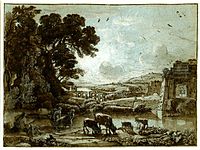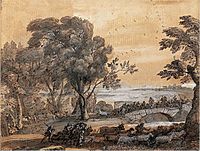
Joseph Mallord William Turner, known in his time as William Turner, was an English Romantic painter, printmaker and watercolourist. He is known for his expressive colouring, imaginative landscapes and turbulent, often violent marine paintings. He left behind more than 550 oil paintings, 2,000 watercolours, and 30,000 works on paper. He was championed by the leading English art critic John Ruskin from 1840, and is today regarded as having elevated landscape painting to an eminence rivalling history painting.
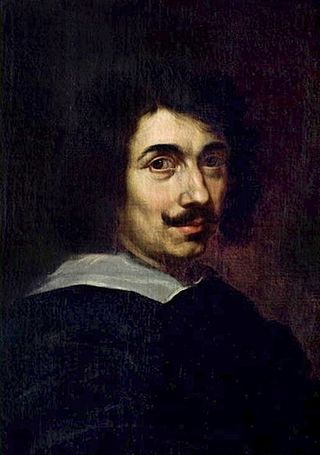
Claude Lorrain was a French painter, draughtsman and etcher of the Baroque era. He spent most of his life in Italy, and is one of the earliest significant artists, aside from his contemporaries in Dutch Golden Age painting, to concentrate on landscape painting. His landscapes often transitioned into the more prestigious genre of history paintings by addition of a few small figures, typically representing a scene from the Bible or classical mythology.

John Sell Cotman was an English marine and landscape painter, etcher, illustrator, and a leading member of the Norwich School of painters.

John Constable was an English landscape painter in the Romantic tradition. Born in Suffolk, he is known principally for revolutionising the genre of landscape painting with his pictures of Dedham Vale, the area surrounding his home – now known as "Constable Country" – which he invested with an intensity of affection. "I should paint my own places best", he wrote to his friend John Fisher in 1821, "painting is but another word for feeling".
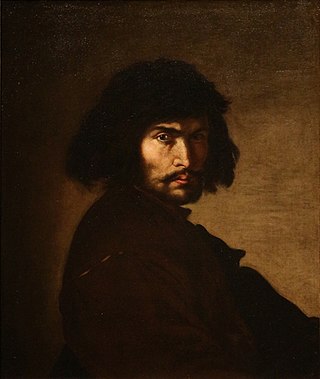
Salvator Rosa is best known today as an Italian Baroque painter, whose romanticized landscapes and history paintings, often set in dark and untamed nature, exerted considerable influence from the 17th century into the early 19th century. In his lifetime he was among the most famous painters, known for his flamboyant personality, and regarded as an accomplished poet, satirist, actor, musician, and printmaker, as well. He was active in Naples, Rome, and Florence, where on occasion he was compelled to move between cities, as his caustic satire earned him enemies in the artistic and intellectual circles of the day.
Jon James Lamont Whiteley was a Scottish child film actor and in adult life a distinguished art historian.

Jusepe de Ribera was a Spanish painter and printmaker. Ribera, Francisco de Zurbarán, Bartolomé Esteban Murillo, and the singular Diego Velázquez, are regarded as the major artists of Spanish Baroque painting. Referring to a series of Ribera exhibitions held in the late 20th century, Philippe de Montebello wrote "If Ribera's status as the undisputed protagonist of Neapolitan painting had ever been in doubt, it was no longer. Indeed, to many it seemed that Ribera emerged from these exhibitions as not simply the greatest Neapolitan artist of his age but one of the outstanding European masters of the seventeenth century." Jusepe de Ribera has also been referred to as José de Ribera, Josep de Ribera, and was called Lo Spagnoletto by his contemporaries and early historians.

Richard Earlom was an English mezzotinter.

Devonshire House in Piccadilly, was the London townhouse of the Dukes of Devonshire during the 18th and 19th centuries. Following a fire in 1733 it was rebuilt by William Cavendish, 3rd Duke of Devonshire, in the Palladian style, to designs by William Kent. Completed circa 1740, it stood empty after the First World War and was demolished in 1924.
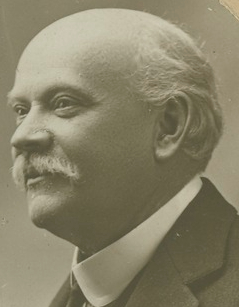
Robert Carl Sticht was an American metallurgist and copper mine manager, active in Colorado and Montana, U.S.A. and in Tasmania, Australia. Sticht was the developer of the first successful purely pyritic smelting in the world. He was also an important book and art collector, a large part of whose collections were acquired by the Public Library of Victoria and the National Gallery of Victoria in the 1920s.
Michael William Lely Kitson was a British art historian who became an international authority on the work of the painter Claude Lorrain.
Josiah Boydell was a British publisher and painter, whose main achievement was the establishment of the Boydell Shakespeare Gallery with his uncle, John Boydell.
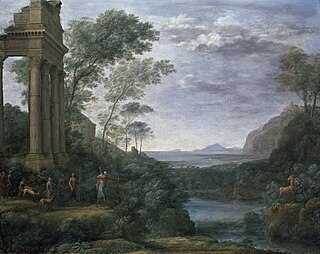
Landscape with Ascanius Shooting the Stag of Sylvia is a painting of 1682 in oil on canvas by Claude Lorrain, a painter from the Duchy of Lorraine who spent his career in Rome. It was painted in Rome for Prince Lorenzo Onofrio Colonna (1637–1689), Claude's most important patron in his last years, and is now in the Ashmolean Museum, Oxford. It is signed, dated with the year, and inscribed with the subject, as Claude sometimes did with his less common subjects.
Henry Rafter was a British master artist who can be categorized as part of the naturalism and realism movements. He is noted for his scenes of landscapes, nature and animals. He was also a prolific book illustrator, and produced several portraits as well. He worked in the 19th century in England, with watercolor and lithographs.

Seaport with the Embarkation of the Queen of Sheba is an oil painting by Claude Lorrain, in the National Gallery, London, signed and dated 1648. The large oil-on-canvas painting was commissioned by Frédéric Maurice de La Tour d'Auvergne, Duc de Bouillon, general of the Papal army, together with Claude's Landscape with the Marriage of Isaac and Rebecca, also now in the National Gallery. It depicts the departure of the Queen of Sheba to visit King Solomon in Jerusalem, described in the tenth chapter of the First Book of Kings. A more usual subject would be their meeting; this is one of many harbour scenes painted by Claude. The Queen is departing from a city with classical buildings, with the early morning Sun lighting the sea, as vessels are loaded.
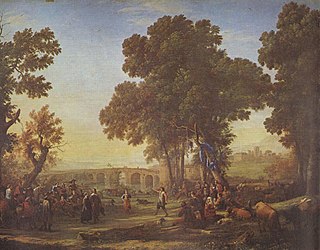
Village Fête is an oil-on-canvas by French artist of the Baroque Claude Lorrain, painted in 1639 and given to Louis XIV in 1693 together with its companion Seaport at Sunset, by landscape architect and gardener André Le Nôtre. It is currently held and exhibited at the Louvre in Paris.
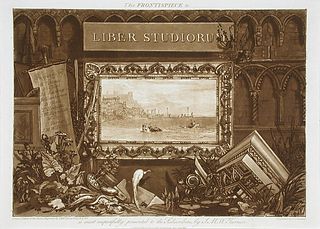
Liber Studiorum is a collection of prints by J. M. W. Turner. The collected works included seventy-one prints that he worked on and printed from 1807 to 1819. For the production of the prints, Turner created the etchings for the prints, which were worked in mezzotint by his collaborating engravers.
Ludovico Caracciolo was an Italian landscapist and engraver. He became a protege of Elizabeth Foster, the second wife of William Cavendish, 5th Duke of Devonshire, who moved to Rome after she was widowed in 1811.

Landscape with the Port of Santa Marinella is an oil on copper painting by Claude Lorrain in the collection of the Petit Palais in Paris. It dates from 1637 or 1638, and is one of a pair commissioned from the artist by pope Urban VIII. It depicts the little harbour of Santa Marinella near Civitavecchia which the Pope wanted to turn into a major port. The other painting in the pair, in the Fitzwilliam Museum, Cambridge, is a view of Castel Gandolfo, a palace on the banks of Lake Albano. It was acquired by the Petit Palais in 1902 as part of the Dutuit bequest.

Landscape with Apollo and Marsyas is an oil on canvas painting by Claude Lorrain, created c. 1639. It is held now in the Pushkin Museum, in Moscow.







